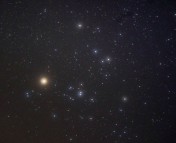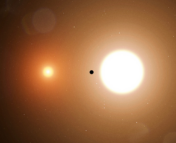This guest post was written by Mark Popinchalk, a PhD candidate at the CUNY Graduate Center and Hunter College, based at the American Museum of Natural History. He studies the relationship between rotation rate and age in low mass stars. He is part of the BDNYC research group and is also a co-host for Astronomy on Tap NYC. Outside of astronomy he enjoys ultimate frisbee, bakes bread, and plays board games. His favorite color is sky-blue-pink.

Title: TESS Reveals that the Nearby Pisces-Eridanus Stellar Stream is only 120 Myr Old
Authors: Jason L. Curtis, Marcel A. Agüeros, Eric E. Mamajek, Jason T. Wright, and Jeffrey D. Cummings
First Author’s Institution: Columbia University, New York, New York
Status: Published in The Astronomical Journal, open access on arXiv
Comoving stars, or stars that move together, are somewhat unexpected. There are lots of stars in the universe, and a lot of directions for the stars to go, so, you would expect any two stars to be moving in different directions. Finding stars moving in the same direction therefore implies something special, namely that they are related somehow, often with a shared history. One of the largest comoving systems is a system of 256 stars that are all moving together, which was discovered early last year. These comoving stars form the Pisces-Eridanus (Psc-Eri) stream, a stream of stars so big that it could fit more than 75,000 of our Solar System inside.
The most likely explanation for why hundreds of stars are moving together is that they formed at the same time and started traversing the galaxy in a group. Therefore, it can be assumed that they are the same age. The original age estimate for the Psc-Eri stream was about 1 billion years old. However, the authors of today’s paper found that the stars are only 120 million years. For some stars that is a big difference, a rough comparison would be being unsure if a human is toddler or teenager! How did the two papers come to such different answers?
The estimate from Meingast et al. came from plotting the 256 stars on the Hertzsprung-Russell (HR) diagram, and trying to fit an isochrone. Isochrones have been covered in many previous Astrobites, but a quick primer is that if you use our understanding of how stars evolve you can draw a line on the HR diagram where a group of stars of different temperatures but all of the same age (in this case Psc-Eri) would be. When the authors plotted the stars from the stream on the HR diagram, the best fit isochrone was consistent with an age of ~1 billion years.
Today’s paper uses a technique that finds the age of a star based on its rotation rate, a method called gyrochronology. All stars spin, and over time the interaction between their stellar winds and magnetic fields slows them down. For a given temperature, the stars that are the slowest spinners will generally be the oldest. Astronomers can use clusters which the ages of the stars are known from different methods to establish a relationship between the age of a group of stars and their rotation rates. (Check out how it was done for the Hyades in this Astrobite). Astronomers have only been able to do this with clusters though, and conveniently located in one part of the sky. How did the authors actually measure the rotation rate of a star, let alone a stream of stars that stretches across almost half the sky? They used the TESS satellite!
TESS (or the Transiting Exoplanet Survey Satellite) launched in 2018 and has been measuring the brightness of stars almost non stop since. It stares at a large patch of sky called a sector for 28 days, imaging the stars every 30 minutes (or every 2 minutes for certain objects), looking for planets blocking light from their stars, amongst other things, and then moving on to the next sector. The rotation rate of the stars will appear to TESS as periodic dimming in the brightness over time, due to starspots on the star. Starspots on the surface of the star will rotate into and out of view of TESS every few days during the course of a stellar rotation. We see a change in the brightness depending on whether or not the spots are visible to the spacecraft, and the frequency of this dimming will be the same as the stellar rotation (see example light curve in Figure 1).
The authors were able to measure the rotation rate of 101 of the 256 candidate members after just the first several months of TESS taking data. How did the rotation rates compare to those of other clusters with well established gyrochronology relations and ages?
Figure 2 shows the rotation rates of stars for a variety of temperatures from some well-known clusters and how they compare with Psc-Eri. Older clusters have stars with longer rotation periods that are trending to the top of the plot, while those of Psc-Eri are very similar to those of the 120 million year old Pleiades star cluster stars. It’s not a perfect match but it’s hard to conclude that Psc-Eri is anywhere near 1 billion years old as originally reported. But how can we reconcile this new younger age with the isochrone/HR diagram argument from the discovery paper?

Returning to the methodology of the discovery paper, it became clear that the three-dimensional movement selection criteria used was going to automatically exclude hotter stars. Today’s authors did a search of their own and found 34 new candidates for the Psc-Eri stream. Once you include these in the isochrone method, it brings the age down to ~120 million years old!
There is still at least one issue, how did Psc-Eri form? It is hard to get a ~120 million year-old cluster to disperse over 400 parsecs and still be moving together so nicely. The authors suggest that maybe Psc-Eri isn’t just one cluster, but a series of small ones that did form together but were also spread out. Either way, this was the first time a stellar stream has been dated by gyrochronology, and it’s an exciting future for the field as TESS observes more of the sky every day.
Edited by: Haley Wahl
Featured image credit: ESA




